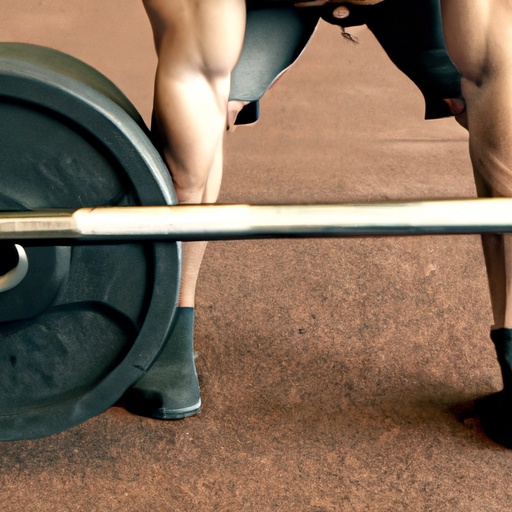
-
Table of Contents
- What Are the Benefits of Gains and How Can I Maximize Them?
- How to Overcome Plateaus and Reach Your Gains Goals
- The Science Behind Gains: What You Need to Know
- The Ultimate Guide to Gains: What You Need to Know
- How to Set Up a Gains Program for Maximum Results
- The Benefits of Progressive Overload for Gains
- The Role of Nutrition in Achieving Gains
- How to Use Rest and Recovery to Maximize Gains
- The Benefits of Tracking Your Gains Progress
“Gains, Explained: Unlock Your Potential and Break Through Your Deadlift Plateau!”
Gains, Explained: How Can I Break Through My Deadlift Plateau? is a comprehensive guide to help you break through any plateau you may be experiencing in your deadlift training. This guide will provide you with the knowledge and tools to help you identify the cause of your plateau and develop a plan to get you back on track. You will learn how to assess your current deadlift technique, identify weak points, and develop a plan to improve your form and strength. Additionally, you will learn how to use different training methods to help you break through your plateau and reach your goals. With this guide, you will be able to take your deadlift training to the next level and reach your goals.
What Are the Benefits of Gains and How Can I Maximize Them?
Gains are the increases in performance, productivity, or efficiency that result from a change or improvement in a system. Gains can be seen in many areas, such as business, education, and health.
The benefits of gains are numerous. Gains can lead to increased profits, improved customer satisfaction, and better employee morale. Gains can also lead to improved efficiency, reduced costs, and increased productivity. Gains can also help to reduce waste and improve the quality of products and services.
To maximize the benefits of gains, it is important to identify areas where gains can be made. This can be done by analyzing current processes and identifying areas where improvements can be made. Once these areas have been identified, it is important to develop a plan to implement the changes. This plan should include a timeline, resources, and goals.
It is also important to measure the results of the changes. This can be done by tracking performance metrics, such as customer satisfaction, employee morale, and profits. This will help to identify areas where further improvements can be made.
Finally, it is important to communicate the results of the changes to all stakeholders. This will help to ensure that everyone is aware of the gains and can take advantage of them.
By following these steps, you can maximize the benefits of gains and ensure that your organization is able to take full advantage of them.
How to Overcome Plateaus and Reach Your Gains Goals
If you’ve been working out for a while, you’ve probably experienced a plateau. It’s that frustrating moment when you’re no longer seeing the gains you’ve been working so hard for. But don’t worry – there are ways to get past plateaus and reach your goals. Here are some tips to help you get back on track.
1. Change up your routine. If you’ve been doing the same exercises for a while, your body may have adapted to them and stopped responding. Try switching up your routine by adding new exercises or increasing the intensity of your workouts.
2. Increase your intensity. If you’ve been doing the same exercises at the same intensity for a while, your body may have adapted to them and stopped responding. Try increasing the intensity of your workouts by adding more weight or doing more reps.
3. Take a break. If you’ve been pushing yourself too hard, your body may need a break. Take a few days off from the gym and focus on getting plenty of rest and recovery.
4. Track your progress. Keeping track of your progress can help you identify when you’ve hit a plateau and make adjustments to your routine.
5. Get enough sleep. Getting enough sleep is essential for muscle growth and recovery. Aim for 7-9 hours of sleep each night.
6. Eat enough protein. Protein is essential for muscle growth and repair. Make sure you’re getting enough protein in your diet.
7. Stay motivated. It can be easy to get discouraged when you hit a plateau, but don’t give up! Stay motivated and keep pushing yourself.
By following these tips, you can get past plateaus and reach your gains goals. With a little bit of hard work and dedication, you can get back on track and start seeing the results you’ve been working for.
The Science Behind Gains: What You Need to Know
Welcome to the world of gains! Whether you’re a seasoned athlete or just starting out, understanding the science behind gains can help you reach your goals faster and more effectively.
Gains are the result of a process called hypertrophy, which is the enlargement of muscle cells due to increased workload. When you lift weights, your muscles are subjected to a greater amount of stress than they’re used to, which causes them to break down and rebuild. This process is what leads to increased muscle size and strength.
To maximize your gains, you need to focus on three key elements: nutrition, exercise, and rest. Eating a balanced diet that includes plenty of protein, carbohydrates, and healthy fats is essential for muscle growth. Exercise should be tailored to your goals and should include both resistance training and cardiovascular exercise. Finally, rest is just as important as exercise, as it gives your body time to recover and rebuild.
Gains are a result of hard work and dedication, but understanding the science behind them can help you reach your goals faster and more effectively. With the right nutrition, exercise, and rest, you can maximize your gains and reach your fitness goals in no time.
The Ultimate Guide to Gains: What You Need to Know
Welcome to the ultimate guide to gains! Whether you’re a beginner or a seasoned pro, this guide will help you get the most out of your workouts and reach your fitness goals.
Gains are the result of hard work and dedication. They come from pushing yourself to the limit and challenging your body to do more than it’s used to. Gains can be physical, such as increased muscle mass, or mental, such as improved focus and concentration.
To get the most out of your gains, you need to understand the basics of how your body works. This includes understanding the different types of exercises, how to properly fuel your body, and how to rest and recover.
When it comes to exercises, there are two main types: compound and isolation. Compound exercises involve multiple muscle groups and are great for building strength and size. Isolation exercises target specific muscles and are great for toning and sculpting.
When it comes to fueling your body, you need to make sure you’re getting enough calories and nutrients. Eating a balanced diet with plenty of protein, carbohydrates, and healthy fats is essential for building muscle and maintaining energy levels.
Finally, rest and recovery are just as important as exercise. Make sure you’re getting enough sleep and taking time to relax and unwind. This will help your body repair itself and prepare for the next workout.
We hope this guide has given you a better understanding of gains and how to get the most out of your workouts. With the right knowledge and dedication, you can reach your fitness goals and achieve the gains you’ve been dreaming of. Good luck!
How to Set Up a Gains Program for Maximum Results

Setting up a gains program for maximum results can be a daunting task. But with the right plan and dedication, you can achieve your goals and maximize your results. Here are some tips to help you get started:
1. Set realistic goals. Before you start any program, it’s important to set realistic goals. Think about what you want to achieve and how long it will take you to get there. Make sure your goals are achievable and measurable.
2. Choose the right exercises. Different exercises target different muscle groups, so it’s important to choose the right exercises for your goals. Research different exercises and find out which ones are best for your goals.
3. Track your progress. Tracking your progress is essential for any gains program. Keep track of your workouts, reps, sets, and weights. This will help you stay motivated and see how far you’ve come.
4. Get enough rest. Rest is just as important as exercise when it comes to gaining muscle. Make sure you get enough rest between workouts to allow your muscles to recover and grow.
5. Eat the right foods. Eating the right foods is essential for any gains program. Make sure you’re getting enough protein, carbohydrates, and healthy fats.
6. Stay motivated. Staying motivated is key to achieving your goals. Find ways to stay motivated, such as listening to music or setting rewards for yourself.
By following these tips, you can set up a gains program for maximum results. With dedication and hard work, you can achieve your goals and maximize your results. Good luck!
The Benefits of Progressive Overload for Gains
Progressive overload is a key concept in strength training and fitness. It is the idea that you should gradually increase the intensity of your workouts over time in order to make gains. This concept is based on the idea that your body needs to be challenged in order to make progress. If you keep doing the same exercises with the same intensity, your body will eventually reach a plateau and you won’t make any further gains.
The benefits of progressive overload are numerous. First, it helps you to avoid plateaus. When you increase the intensity of your workouts, your body is forced to adapt and grow stronger. This helps you to keep making progress and avoid hitting a wall.
Second, progressive overload helps you to build muscle. When you increase the intensity of your workouts, your body is forced to use more energy to complete the exercises. This energy is used to build muscle, which helps you to look and feel better.
Third, progressive overload helps you to burn fat. When you increase the intensity of your workouts, your body is forced to use more energy to complete the exercises. This energy is used to burn fat, which helps you to look and feel better.
Finally, progressive overload helps you to stay motivated. When you increase the intensity of your workouts, you are more likely to stay motivated and keep pushing yourself. This helps you to stay on track and reach your goals.
Overall, progressive overload is an important concept in strength training and fitness. It helps you to avoid plateaus, build muscle, burn fat, and stay motivated. If you want to make gains, it is important to gradually increase the intensity of your workouts over time.
The Role of Nutrition in Achieving Gains
Good nutrition is essential for achieving gains in any area of life. Whether you’re looking to build muscle, lose weight, or just stay healthy, nutrition plays a key role in helping you reach your goals.
When it comes to building muscle, the right nutrition is essential. Eating a balanced diet that includes plenty of protein, healthy fats, and complex carbohydrates will help you build muscle and strength. Eating enough calories is also important, as your body needs energy to build muscle.
If you’re looking to lose weight, nutrition is just as important. Eating a balanced diet that includes plenty of fruits and vegetables, lean proteins, and healthy fats will help you lose weight and keep it off. Eating fewer calories than you burn will also help you lose weight.
No matter what your goals are, eating a balanced diet is key. Eating a variety of foods from all the food groups will help you get the nutrients you need to stay healthy and reach your goals. Eating plenty of fruits and vegetables, lean proteins, and healthy fats will help you get the vitamins and minerals you need to stay healthy.
In addition to eating a balanced diet, staying hydrated is also important. Drinking plenty of water throughout the day will help keep your body hydrated and functioning properly.
Overall, nutrition plays a key role in helping you achieve your goals. Eating a balanced diet and staying hydrated will help you reach your goals and stay healthy.
How to Use Rest and Recovery to Maximize Gains
Rest and recovery are essential components of any fitness routine. Taking time to rest and recover can help you maximize your gains and reach your fitness goals. Here are some tips to help you make the most of your rest and recovery:
1. Get Enough Sleep: Sleep is essential for muscle recovery and growth. Aim for 7-9 hours of sleep each night to ensure your body has enough time to rest and repair.
2. Take Rest Days: Make sure to take at least one day off from exercise each week. This will give your body time to recover and prevent overtraining.
3. Eat Right: Eating a balanced diet with plenty of protein, carbohydrates, and healthy fats will help your body recover and build muscle.
4. Stretch: Stretching can help reduce muscle soreness and improve flexibility. Aim for 10-15 minutes of stretching after each workout.
5. Foam Roll: Foam rolling can help reduce muscle tension and improve circulation. Aim for 5-10 minutes of foam rolling after each workout.
6. Hydrate: Staying hydrated is essential for muscle recovery. Aim for 8-10 glasses of water each day.
By following these tips, you can ensure that your rest and recovery are helping you maximize your gains. Remember, rest and recovery are just as important as your workouts, so make sure to take the time to give your body the rest it needs.
The Benefits of Tracking Your Gains Progress
Tracking your gains progress is a great way to stay motivated and stay on track with your fitness goals. It can help you stay focused and make sure you are making progress. Here are some of the benefits of tracking your gains progress:
1. Accountability: Tracking your progress helps you stay accountable to yourself and your goals. You can easily see how far you have come and how much progress you have made. This can help you stay motivated and keep pushing yourself to reach your goals.
2. Measurement: Tracking your progress allows you to measure your progress over time. You can easily see how much you have improved and how much further you need to go. This can help you stay focused and make sure you are making progress.
3. Motivation: Tracking your progress can help you stay motivated and keep pushing yourself. Seeing your progress can be a great source of motivation and can help you stay on track with your goals.
4. Improvement: Tracking your progress can help you identify areas where you need to improve. You can easily see where you are lacking and what you need to work on. This can help you make the necessary changes to reach your goals.
Tracking your gains progress is a great way to stay motivated and stay on track with your fitness goals. It can help you stay accountable, measure your progress, stay motivated, and identify areas where you need to improve. So, start tracking your progress today and see the results!#Gains, Explained: How Can I Break Through My Deadlift Plateau? has provided a comprehensive overview of the various strategies and techniques that can be used to break through a deadlift plateau. From changing up your routine to focusing on form and technique, there are a variety of ways to make progress and break through a plateau. With the right approach and dedication, anyone can make progress and reach their goals.



